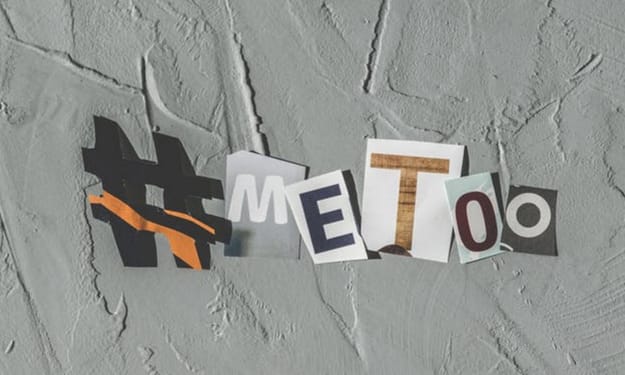"But Women Abuse Men, Too..."
It's true, but it's not that simple.

Well, yes, there are women who abuse men. This well-known fact is brought to our attention whenever violence against women is discussed, just so the men don’t feel left out (nothing to do with derailing the original conversation, of course.) But we also know that there are far fewer women that abuse men, than there are men who abuse women. Nothing new learned here. But there is something that can be learned from the domestic violence statistics that may change our assumptions about the way intimate partner abuse manifests itself. There is a pattern along gender lines, but it might not be what you think.
Looking At the Basics
- One in four women in the UK will be subjected to domestic abuse during their lifetime. Globally, the figure rises to an average of 1 in 3 women. Lesbians are four times as likely to be abused by a partner than heterosexual women.
- One in six men will experience domestic abuse at some point in their lives.
- Half of all gay & bisexual men will experience domestic violence.
- One in ten men who report domestic abuse to the police state that the perpetrator is also a man. Gay men are twice as likely to be abused by a partner as heterosexual men.
- The problem is completely out of control for transgender people: 80% of trans individuals will be on the receiving end of domestic abuse.
- In the UK, two women are murdered each week by a partner or ex-partner.
- 30 men are murdered each year by a partner or ex-partner.
- 94% of murder victims will have been stalked by their attacker. Yes, you read that right. Ninety-four percent.
We can see that the inclusion of same-sex relationships highlights an often overlooked problem — domestic violence is not solely a heterosexual issue, and it is actually more common in same-sex relationships. LGBT people in relationships can also have differing manifestations of relationship power dynamics, and ideas about traditional gender roles may not apply. Overall, the trend is for more men abusing female partners than any other permutation, but this does not mean that it is the only form of abuse that happens. Unfortunately, this trend results in more women dying, or suffering serious injury, as a result of domestic violence than men. Resources are limited, and services are geared towards providing refuge from physical violence rather than other types of abuse — because the loss of a life is the most serious transgression against a person, that is where prevention efforts are targeted. This means that many victims are suffering terrible conditions because it hasn't got "that bad" yet.
When researching this article, I was shocked by the amount of relationship abuse that exists, whatever the genders. It is appalling. Even though the crime statistics appear to show a downward trend in overall domestic abuse, it's still far too common. It's not an exaggeration to say it's an epidemic.
The Dynamics of Abuse
There is only one prerequisite needed for partner abuse to occur: an intimate relationship with a power differential. Many other factors can increase the likelihood, but without an imbalance of power, it is impossible. And no matter what the background leading up to the violence, it is always the perpetrator's choice to abuse and control. As we will discuss, that power can take many forms.
The Distribution of Power
Throughout history, men have held positions of power (over women, and other men,) and in everyday life men have typically been at an advantage overall. In spite of technological and social advances, life’s shape-sorter (patriarchy) filters women out at the lower levels, and gives men a more advantageous starting point. This is a pattern that has developed over time, and has reinforced itself due to its being unchallenged until very recently.
Thoughts, Desires, and Actions
We all have unconscious (or conscious) biases, and there are behaviours and emotions that we tend to associate with one gender or another. However, we also know that there are actually very tiny and barely significant differences between the brains of women and men. In spite of our ability as humans to experience the full spectrum of feelings and urges, regardless of gender, men and women do often behave in stereotypical ways. But recent studies have demonstrated consistently that these differences are mostly the result of upbringing and conditioning. There is a social penalty attached to behaving in ways that do not correlate with one’s perceived gender, and as observers we expect men and women to follow the rules dictated by social convention, no matter how much we believe ourselves to have eliminated these prejudices from our minds.
As a result, there is the possibility that we may overlook abusive behaviour perpetuated by women. But that’s certainly not the whole story. It’s difficult to tell whether men and women experience, with the same frequency, the desire to control another human; but we do know that there are more external checks that prevent women from acting upon such thoughts.
Don’t Blame It On Hormones
Before we continue with this point, it is worth mentioning here the role of testosterone. Higher levels of testosterone are associated with higher occurrences of aggression and risk-taking behaviour, but this tells us nothing about the thought processes that accompany male violence. Recent studies have determined that the relationship between testosterone and violence is non-linear, and that it is just one factor. Indeed, there is ample evidence that abusers do not act on impulse, but instead carefully plan their actions. Anger, provocation, and substance abuse are often used as rationalizations for the abuse, but these are excuses and not explanations. An abuser retains control of their actions in order to intimidate their victim.
Testosterone also provides an additional stumbling block for female abusers. It enables men to grow muscle mass more effectively, and contributes to their taller stature. Even if a woman wanted to physically dominate a man (BDSM aside), the odds are stacked against her in most cases. This is arguably the most important reason why men kill a current or former partner at a rate three times higher than women do - they are physically more capable of killing. In addition to the higher risk of death that female victims face, there is asymmetry in the charges brought. A man can beat a woman to death with his bare hands and claim it was a “crime of passion”, thereby attracting a charge of manslaughter. A woman, however, would almost always need to use a weapon to overpower her (male) spouse, making it easier to prove premeditation and therefore murder.
Social Stigma
We must recognise that some men are the victims of physical and sexual violence perpetuated by women. This can happen if the male partner refuses to be violent to a woman as a matter of principle, even in self-defence. There is some evidence to suggest that male victims fear being accused of domestic abuse themselves. A manipulative woman will look for and play on the same traits that an abusive man would, but with the knowledge that a male victim will be viewed differently by the outside world. Such a victim may feel ashamed, or that he will not be taken seriously, as a result of the same prejudices and social hierarchies that place women at a disadvantage generally.
A False Dichotomy
It is, however, a misconception that men abuse physically, and women manipulate emotionally. There is a psychological element to all abuse, whether it escalates to physical violence or not. And that is precisely where this belief stems from. For female abusers, it may remain at the psychological level only (which is still harmful) because they lack the physical capability to use violence as a tool of control. It is a lack of opportunity, not a conscious choice, that gives rise to this incorrect belief.
It's the Patriarchy, Stupid
Back to the social checks on behaviour. Abusers tend to do as much as they can get away with, and rationalise their actions, even if they are illegal or morally abhorrent. Our social attitudes play a role in deciding what behaviour we condone in ourselves and others. Unfortunately the combined sum of our prejudices has created a situation in which men can get away with more, and women can take fewer liberties. It ranges from policing the speech, emotions and character traits of men and women; to ideas about the behaviour and criminality of the genders. We see this in the way that women are judged harshly for being confident and outspoken, while men are lauded; we see it whenever men are practically deified for caring for their own children, whereas women are subject to constant criticism; and we see it when men are excused for sexually inappropriate behaviour, yet women are vilified for having sex whether they consent to it or not.
These discrepancies affect how we police our own behaviour, and that of others. A woman is more likely to watch what she says and does and be more restricted by gender expectations. A man is expected to be forthright and confident without disapproval, and to reject "feminine" behaviours. Subtle social messages like these contribute to the circumstances in which one gender is noticeably worse-off and less likely to flout boundaries or feel entitled to other people’s time and attention.
Boys Will Be Boys
Throughout life, men and boys are brought up to believe that they are permitted to treat women as sexual objects and domestic servants. Cultural reinforcement spreads the message that women are less intelligent and inherently untrustworthy. These subtle messages can be unlearnt, but they are everywhere, and they help to convince the abuser that they are justified in treating women this way. The chances are that he is disrespectful to women in other areas of his life as well, although he may disguise it and present a respectable persona when needed. There is no corresponding set of messages for women and girls that men are stupid, sexual objects worthy of contempt; although girls are raised to be quiet, compliant, and obedient, creating the counterpart to male abusive behaviour and compounding the problem.
And so, while a difference in power is necessary for abuse to happen, a sense of entitlement and harmful beliefs about potential victims makes it far more likely. Power by itself does not cause abuse; most of us will hold a position of relative power at some point in our lives without using domineering and demanding behaviour against others. The difference in behaviour expected of, and towards, men and women provides more opportunities for men to abuse than it does for women. We expect, and condition, women to be pleasant, compliant and meek. They must tolerate a man’s foibles and faults, and not argue back. Men are trained to be authoritative, in control, and the primary breadwinner. Even though we are striving for better equality, these beliefs still prevail, and relationships do tend to exist along these lines, even among the younger generation.
A Confidence Trick?
Other external factors stemming from patriarchy can place women in a weaker position that facilitates abuse against them. The asymmetrical beauty standards applied to men and women may appear superficial and irrelevant to some, but the media items aimed at women consistently promote one narrow view of beauty, and are designed to convince women that they need to change their bodies just to be acceptable. There is even a correlation between approval of these beauty ideals and the holding of sexist views. Advertising and news items of this nature are linked to low self-esteem and the prevalence of eating disorders. These external, pervasive messages provide an easy opportunity for an abuser to weaken their victim by insulting and shaming their partner’s body and appearance, undermining their sense of self-worth and making them more vulnerable and dependent on the abuser. At the time of writing, the majority of patients with body image disorders are female, but it is now recognised that eating disorders among men are on the increase.
Money, Money, Money
Next, we come to a very practical consideration: money. Even in 2017, women on average earn less than men, occupy fewer senior positions in the workplace, and experience slower career progression than men. Financial independence is harder, overall, for a woman to achieve than for a man, and even more so if her abusive partner controls her money. It is easy to be drawn into an arrangement that seems responsible at first, yet descends into an abuse of power once the victim’s agency is removed. This could take the form of investing in a property where cash is tied up and therefore inaccessible, or worse, where one partner’s name is not on the deeds (guess which one.) It might mean paying into a joint bank account, to cover bills and household expenses, yet having no say or knowledge over where the money is going. It could be so bad that the abusive partner has complete control over the victim’s finances. It is even worse if the victim is unwaged.
Related to money is the even more practical matter of childcare. Aside from the risk and inconvenience of pregnancy, at the end of it there exists a dependent, living being that somebody is going to need to look after. These days, fathers say they want to play a more active role in their childrens' upbringing. We are slowly creeping towards equal parenting, but we are by no means living in a Nordic utopia. An abusive male partner will take advantage of traditional gender roles in this regard, forcing the female partner to be responsible for the children and housework, even finding her additional tasks to keep her occupied and exhausted. These unreasonable demands can prevent a woman from finding work outside of the home; another route to freedom cut off. It would take not only manipulation of the individual, but a complete turning of the tables, for a woman to successfully control a man in this regard. It’s possible, but very difficult.
When Do Women Abuse?
There are certain conditions that are more conducive to abuse by women, although they typically aren't in a domestic setting. The conditions that allow women to abuse are the same conditions where the majority of female serial killers are found. They tend to involve a caring aspect, in professions where women are over-represented (see, gender imbalance is harmful even when it favours women) such as nursing and education. There are still many examples of male perpetrators operating in these fields, but it tends to be the area where we see a high proportion of female abusers. Examples include the Magdalene Laundries of 20th Century Ireland, and adult abuse in care homes. A dangerous aspect of this type of abuse is that we don't expect carers to abuse their wards, and we don't expect women to be abusers. Bullying and neglect within institutions relies on the residents being unable to defend themselves or speak out, and the abuse is easy to conceal. Those abused are significantly weaker than the perpetrators, and there is a power imbalance that would not be found outside of the institutional setting. So we can see that women do sometimes abuse (it's still very rare), but the conditions need to be right.
Not lack of agency, but lack of opportunity
While there is limited information available on female abusers, we know that they do exist, albeit in smaller numbers than men, and in specific circumstances. The popular perception is that they either do not exist, or act under duress, but recent research suggests that female abusers have simply been overlooked due to the idealisation of women.
One thing we do know is that women aren't delicate little flowers, incapable of thinking terrible and wicked thoughts. We may not like it, but each and every one of us is capable of wishing harm on others, if we choose to. Abusers are ordinary people, not cartoon monsters. Perhaps there are women who would control and dominate their partners, given the chance. But that chance arises so infrequently due to the limitations that our society places on women, and the additional freedoms it offers to men.
An Unequal Struggle
Domestic abusers do what they do in order to exert control over their victim. It’s far easier to justify it to themselves if the culture supports beliefs that one gender is inferior, and it’s more difficult for victims to leave or to be believed. At present, Western culture makes it far easier for men to abuse than it does for women. There is also the obvious difference in average size and strength, but this only accounts for the violent aspects of abuse.
The inequalities that keep women’s progress lagging behind men’s are the same inequalities that allow domestic abuse to perpetuate. All actions we perform on this earth are some balance of nature and nurture, but we still hang on to outdated beliefs that reinforce the gender divide. Perhaps even more dangerously, these relics of the past manifest in subtle messages and prejudices that are hard to pin down and identify as sexism. We’re getting better at tackling the problem, but it is heavily entrenched. Sadly, this gender inequality creates the conditions for domestic abuse to be perpetuated mainly by one gender. If we can tackle the problems of rape culture and patriarchy (yes – these do harm men as well!,) then hopefully we can solve the abuse problem, too – not just reducing violence against women, but to reduce all domestic violence.
About the Creator
Katy Preen
Research scientist, author & artist based in Manchester, UK. Strident feminist, SJW, proudly working-class.






Comments
There are no comments for this story
Be the first to respond and start the conversation.